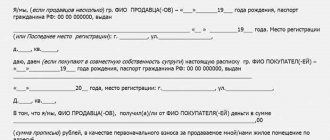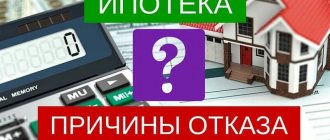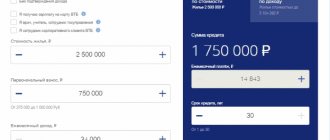The procedure for replacing collateral in Sberbank
Sberbank is the largest credit institution, highly popular among the Russian population.
Its lending conditions are characterized by minimal interest rates, a loyal attitude towards borrowers and fast processing times. The procedure for replacing collateral at Sberbank has a number of its own features. In particular, these include the following nuances:
- the exchange of a mortgaged apartment for another occurs upon a written application from the client;
- the borrower provides a full package of mortgage documents for himself and all co-borrowers and guarantors for the current mortgage (passports, certificates, employment certificates, etc.);
- a package of documents is provided for the apartment that is being replaced (appraisal, title documents, etc.);
- the bank considers such an application from the borrower within 30 days;
- if Sberbank’s decision is positive, then an additional agreement is signed to the mortgage agreement on the change of collateral;
- There is a simultaneous registration of a new pledge and the removal of the encumbrance on the first apartment in the justice authorities.
A credit institution may accommodate the applicant halfway and authorize the transaction if the borrower meets the following requirements:
- The mortgage loan is repaid for at least 4-5 years, and some banks require repayment of at least half of the amount.
- The client does not have any late payments.
- The living space is located near a bank branch.
You can dispose of real estate that is under a mortgage only with the permission of the bank. In fact, to exchange an apartment, you must first remove it from encumbrance. The bank will do this only when the borrower has fully paid under the loan agreement. Therefore, to resolve the issue, you must first contact the lender.
Attempts to carry out an operation without permission may lead to the bank, citing a gross violation of the loan agreement, demanding early repayment of the debt. A borrower who has not allowed any delays to occur and fulfills all the bank’s requirements in a timely manner, including those related to concluding insurance contracts, is more likely to receive permission. It is better if the current loan agreement was concluded at least two years ago, and the borrower has repaid at least a third of the loan over the past period.
The borrower should understand that the bank may authorize the exchange, but is not obligated to do so. For the lender, such a procedure is unnecessary paperwork, which carries certain risks. Therefore, the borrower’s task is to fulfill all the lender’s requirements regarding the provision of documents and compliance with the procedure.
Preliminary permission from the bank must be obtained before starting the search for a new apartment owner and choosing a new home. Otherwise, the borrower may waste time and money.
The requirements for the collateral that will serve as security after the exchange are the same as for obtaining a loan. The bank will check all documents for the property, as well as its legal purity.
Nuances of exchange in Sberbank
Sberbank is the undisputed leader in the field of banking services in the Russian lending market, so borrowers who have taken out a mortgage with this lender and want to exchange the collateral will do well to familiarize themselves with the specifics of the exchange.
Exchange of an apartment with a mortgage at Sberbank is characterized by the following features:
- The exchange is carried out on the basis of a written request from the borrower. At the same time, along with the application, it is necessary to provide all documentation regarding the current loan agreement and participants in the credit relationship, including passports, income certificates and copies of work books of guarantors and co-borrowers;
- The lender must provide comprehensive information about the replacement, including an appraisal report, as well as technical and title documentation for the selected apartment;
- The bank needs time to consider the application. Typically this period does not exceed 30 days;
- If approved, the borrower signs an additional agreement with Sberbank providing for the replacement of the collateral;
- Based on the signed agreement, the encumbrance on the old apartment is removed and at the same time a pledge document is drawn up for the new one.
The rest of the order is general, which varies depending on the method of exchange. It is only important to note that Sberbank treats such procedures with special care and acts exclusively in its own interests, so the chances of exchanging a mortgaged apartment in Sberbank are high for those who are considered a bona fide borrower, do not allow delays and meet the main requirements of the lender.
Is it possible to exchange a mortgaged apartment: nuances and legislation
In accordance with Russian legislation and the signed loan agreement, the bank is the mortgagee of the real estate and an interested party. Therefore, any actions with encumbered real estate should be carried out only with the consent of the creditor.
Such actions include sale, exchange, any improvements to living space, and in some cases even rental. In particular, according to 102-FZ, it is established that with the consent of the mortgagee bank, an apartment can be donated, exchanged, sold, made as a contribution to the property of a business partnership, etc.
The legislative act regulating the process of replacing collateral, in addition to 102-FZ, is the Civil Code of the Russian Federation (Article 345). It is these documents that establish the norms, rules and the possibility of exchanging real estate pledged under a mortgage agreement.
In the procedure for direct exchange of an apartment pledged on a loan, there are the following nuances:
- The exchange involves replacing the existing collateral, that is, re-issuing a mortgage on another property.
- The bank may give its consent to replace the collateral, but it is not obliged to do so.
- The replacement process is regulated not so much by the loan agreement concluded with a specific borrower, but more by the internal provisions, instructions and regulations of the bank (some lenders may allow an exchange only after the debt has been repaid for more than half of the loan term, others are not strictly tied to the date of the transaction).
- Exchange of one apartment for another is possible only if the client has a positive credit history (no long-term arrears).
- The purchased property must cover the balance of the debt (including accrued interest) with a discount of at least 20-30%.
Replacing mortgage collateral
Article 345 of the Civil Code of the Russian Federation clearly states that replacement of mortgage collateral is possible after the consent of the mortgagee, that is, the bank.
From a legal point of view, the transaction can be carried out. But in reality, this is a complex procedure that will require spending a lot of money. You will have to go through the same procedures again as when applying for a mortgage. Each action will have to be coordinated with the banking organization.
This happens quite often. The borrower inherits the property and wishes to provide it to the bank as collateral. Thus, he can immediately obtain ownership of the mortgaged home.
If something happens to the initial collateral, the borrower loses ownership of it; it must be replaced with any property of equal value.
Exchange of an apartment with a military mortgage
The exchange procedure itself can be performed in the following ways:
- transaction based on an exchange agreement with subsequent replacement of collateral;
- conclusion of two sales contracts: sale of an old apartment and purchase of a new one;
- using a short-term unsecured loan.
The choice of method depends on many factors, but first of all, on the bank’s desire to carry out this or that operation.
If preliminary permission to exchange the collateral apartment has been received, the borrower can begin to select options.
We suggest you read: Expertise and assessment of damage from flooding of an apartment
It is usually advisable to conclude a transaction on the basis of an exchange agreement in a situation where the apartments have approximately the same value. This could be, for example, an object with similar technical characteristics and attractiveness, but in a different area.
If the borrower wishes to move to another locality, a number of technical difficulties arise. At a minimum, the new bank in the region of residence must have a bank branch, otherwise, obtaining permission to exchange will be unlikely.
Also, the bank is more likely to accommodate the client if he wants to become the owner of a more expensive apartment, especially when there is no talk of increasing the loan amount. The bank thus receives more expensive collateral.
If the borrower wants to buy an object that is more expensive and increase the loan amount, then it is better to make two sales contracts.
The most difficult thing is to get permission from the bank when exchanging for cheaper housing. The lender can agree to the operation only on the condition that most of the debt has already been repaid, and the loan amount is at least 20-30% less than the cost of the new home. The easiest way to justify such a decision to the bank is a decrease in income and the inability to fulfill the terms of the original loan agreement.
- Providing documents for a new apartment to the bank.
- Coordination of all terms of the transaction.
- Signing the exchange agreement.
- Placing an encumbrance on a new pledge.
- Removing the encumbrance from the old collateral.
The complexity of such a transaction also lies in the fact that it is not easy to find a property owner who would agree to accept an encumbered apartment for exchange.
- Searching for a buyer for an apartment that is under mortgage.
- The borrower obtains a short-term consumer loan in an amount sufficient to repay the remaining balance of the mortgage.
- Repayment of a mortgage loan at the expense of a consumer loan.
- Removing the encumbrance from the apartment.
- Signing the purchase and sale agreement. The money received from the transaction is primarily used to repay the unsecured loan.
- Purchasing a new apartment with an encumbrance.
If the amount of the required consumer loan is significant, the bank may require a guarantee from one or more persons.
The positive aspect of this option is that it is easier to find a buyer for an apartment that is not under a mortgage at the time of signing the sale and purchase than for an encumbered property. But there are certain difficulties:
- A bank that issues a consumer loan can impose very high solvency conditions on the borrower, since he will have two loans for a certain period of time.
- Transactions should be as close as possible in time, and it is better to do this on the same day.
The best option would be a situation where the borrower finds both a buyer for his property and a new home, and only then receives a consumer loan and carries out transactions. It is also possible to provide other real estate for collateral. The latter option may not be profitable, because a mortgage involves certain costs associated with registration. Taking into account the fact that the loan must be repaid in a very short time, it is better to opt for the unsecured option. This will reduce paperwork.
To obtain a consumer loan, the borrower will need to provide the entire package of documents, including income certificates. A loan can be issued both on a general basis, if the bank has an appropriate product, and on an individual basis.
- Obtain the bank's permission in principle to sell an apartment that is pledged.
- Find a buyer, who must be warned at the first stage of negotiations that the apartment is encumbered.
- Find an apartment that the borrower would like to purchase.
- Obtain the bank's consent to issue a new mortgage (the lender may already be different).
- Sell your old apartment.
- Buy a new apartment with a mortgage loan.
If a potential buyer of an apartment that is pledged does not have enough funds and wants to contact the bank, then the current lender can replace the borrower. The original borrower receives the difference between the cost of the apartment and the loan balance. This money is often used to pay the down payment on a new mortgage.
This option gives the borrower a greater choice among real estate objects, in contrast to the option of concluding an exchange agreement. But the main difficulty is to find a buyer willing to sign a purchase and sale agreement with the condition that the apartment is pledged.
The borrower can change not only housing, but also the lender. If at the time of the first loan the conditions of the current lender for the borrower were optimal, then the situation during the exchange period could change.
This is the option most often offered by banks to borrowers, since credit institutions bear the least amount of risk.
Whatever method is chosen by the borrower and the bank, it is worth carefully preparing for the procedure. The apartment that will be transferred to the mortgage must be carefully checked. It is better for the borrower to enlist the support of a lawyer at all stages of the operation. If at one of the stages something goes wrong, you can be left without housing.
Is it possible for a military member to change the mortgaged living space to another? The most difficult case is the change of housing received by military personnel under special conditions. program.
Such apartments are pledged to two organizations at once: the bank and Rosvoenipoteka.
We suggest you read: Divorce with a mortgaged apartment
However, there are cases when such a transaction is provided for by the contract.
If a military man is transferred to serve in another city, then according to the contract the transaction is carried out in accordance with the “Movement” clause. The procedure is carried out according to the scheme of equal exchange. Credit organizations replace the collateral.
If the exchange is made for a larger or smaller living space, then a scheme will be required to repay the loan amount and the amount of contributions to Rosvoenipoteka.
The encumbrance is removed, then a new mortgage agreement is drawn up.
Exchanging a mortgage on an apartment is a complex and rather risky process. To obtain a guaranteed result, it is more advisable to seek help in implementing your plans from the employees of a reliable real estate agency.
How can you exchange an apartment with a mortgage for a house?
Obtaining a mortgage is a fairly serious and responsible procedure. Firstly, we are talking about large sums, and secondly, the contract is concluded for many years. However, in life it happens that the borrower needs to move to another region or a different type of housing. Therefore, today the question is relevant: how can you exchange an apartment with a mortgage for a house?
Replacing a mortgage is a very complex procedure that requires taking into account all the important nuances before proceeding. It is advisable to first consult with a lawyer so that the transaction is successful.
Remember! A mortgage does not at all mean that until the end of its term the borrower cannot do anything with the apartment purchased with borrowed funds. Such real estate is only temporarily listed as bank property. But if you have the bank’s consent, it can be sold and exchanged. The main thing is that two conditions are met:
- More than 2 years must pass from the date of taking out the mortgage (in some cases this period is increased to half the entire loan period).
- The client must have a positive credit history and no late payments.
- The new housing is located near the bank branch chosen as the lending institution.
Among the operations with mortgage property the following can be distinguished:
- Exchange of housing in order to move to a more expensive one.
- Relocation to residential property of equal value.
- Exchange of housing when moving to a cheaper one.
Each option has its own characteristics - exchange procedures are carried out differently. An exchange differs from a sale in that most or all of the value does not convert into cash.
In this case, the bank’s collateral is automatically changed, that is, one real estate secured by the lender is replaced with another. This procedure involves two parties who change living space. In addition, a third party is expected to participate as a controller.
What are the exchange conditions and is there an alternative?
The reason for exchanging an apartment with a mortgage for a private house can be anything. For example, an increase or decrease in income, a desire to obtain a different type of real estate with a different degree of comfort, a decrease or increase in income, and much more.
Free transactions are hampered by the fact that housing is pledged. In theory, exchanging an apartment is not so difficult, but in practice everything looks different.
First of all, for such a transaction you need to obtain consent from the creditor bank, since it is with him that the apartment is pledged. You just need to contact the financial institution with a written request to make an exchange.
The following documents are attached to the application:
- Passport (copy and original).
- Marriage certificate, if available.
- Extract from the house register.
- A copy of the personal account.
- Papers that confirm timely payment of debt.
As a rule, financial institutions accommodate borrowers who fulfill their obligations in good faith.
Main nuances
- According to the terms of the lenders, the exchange of real estate taken on credit is possible only upon concluding an agreement for the sale of an existing apartment and the purchase of a new house that meets the requirements of the credit institution.
- The bank must evaluate the new collateral, and the borrower is charged a fee for this procedure.
- Before the exchange, the borrower must re-provide a complete package of documents required to conclude a mortgage.
- If necessary, an application is written to increase the size of the mortgage by the amount of the difference.
- Some financial institutions require the client to make an immediate down payment for a new home.
- A credit institution is more willing to agree to a deal if the borrower contacts a real estate agency with which this bank cooperates. And if the client also received his first home through this agency, then the subsequent purchase will become more affordable.
- The bank can check your credit history again (read about its meaning at this link) to identify negative information in it. If violations are noticed, the exchange may be refused.
How exactly is the exchange made?
If the creditor does not want to satisfy the client’s request for an exchange, then you will have to accept it. There is nothing you can do, you will have to live in the same place or look for alternative solutions to the problem.
If the bank agrees, the procedure will be significantly simplified and will consist of the following:
- Concluding two real estate purchase and sale agreements, while the apartment being sold will still be held as collateral by the bank.
- After registering ownership of the new home, it is transferred as collateral to the credit institution.
- The bank removes the encumbrance from the sold apartment, and the new owner will have to undergo state registration of ownership.
The benefit of such a transaction accrues only to the borrower, and therefore it will be quite difficult to find a buyer of real estate who will agree that for some time it will be pledged to the bank. The seller will have to prepare a number of papers so that the buyer can insure his new property.
Documents required for exchange
- Cadastral and technical passports (issued by the BTI).
- Conclusion of the assessment on all types of housing costs, primarily market prices.
- Papers that confirm the seller’s ownership (deed of gift, purchase and sale agreement, etc.).
- An extract from the state register, which confirms the fact that the housing is free of encumbrances.
What's the alternative?
If for some reason a person does not want or is not able to exchange an apartment for a house, then he can use another option to acquire a new home - sell the mortgaged apartment and buy a house.
The algorithm is as follows:
- Collection by the borrower of all necessary documents for a new mortgage.
- Submitting an appropriate application and waiting for the bank to make a decision. We consider the best offers on mortgage transactions at this link.
- The encumbrance is removed from housing secured by the bank (we’ll talk more about this here). This is done by releasing the property from collateral using a short-term loan.
- Previous housing is quickly sold on the market at a very attractive price.
- The proceeds from the sale can be used to pay off a short-term loan.
- The remaining money is needed to purchase new square meters.
Important! It is necessary to obtain confirmation in advance from the lender that he is ready to provide a loan for the purchase of another home, otherwise the borrower may find himself without an apartment and without his own home.
In the alternative option presented above, it is also possible to change the bank when conducting transactions.
The role of price differences
This leads to the client being forced to write an additional application to change the size of the mortgage loan.
There are three options:
- The best option is an equivalent exchange of real estate, when the client exchanges an apartment with a mortgage for a house of equal market price. At the same time, new real estate may be smaller in area, but newer and of higher quality, more attractive from the buyer’s point of view. It is also possible to exchange for housing that is more spacious, but not of such high quality. This option is the most attractive not only for the client, but also for the bank, since the procedure is the simplest and goes much faster. The chances are even higher if the new housing is located near the lending bank. By the way, we talk about real ways to increase your chances of getting approved for any type of loan at this link.
- A situation where a new home is more expensive. In this case, the bank will be even more interested, since the new collateral is higher in its market value. It is better when the difference in price exceeds 20%, then the lender is likely to make a positive decision with permission for an additional payment. The main problem for the borrower is where to get additional money. Some people prefer to take out consumer loans; better offers are presented at this link. And some people just want to make extra money quickly. We tell you how to quickly do this here.
- A new house is cheaper. This is the most difficult option, since the bank does not consider it attractive to receive collateral that has a lower value. The lender may agree to such a procedure if about 2/3 of the mortgage has already been repaid. That is, the borrower will have to either wait for this moment or look for additional funds for partial early repayment.
Another important case is the exchange of an apartment taken as part of a military mortgage. This is one of the most complex procedures, since there is a double burden - banking and Rosvoenipoteka.
There are only a few options:
- Transfer of service to another region. This is provided for in the military mortgage agreement in the “moving” clause. The procedure is similar to that for an equal exchange; the housing must be near the military’s place of service.
- Calculation of the loan under the Rosvoenipoteka program.
To summarize, it is worth mentioning that the conditions for the exchange of real estate are often specified in the contract in advance, so you need to be very careful when signing the papers.
What the law says
The procedure for regulating relations between the bank and the borrower occurs on the basis of a loan agreement, which is drawn up in accordance with the legislation of the Russian Federation. Article 6 of Federal Law No. 102 states that each mortgage loan is based on collateral, which is the purchased property. An exchange is a replacement of collateral, that is, a re-issuance of a loan for another property.
The procedure for this procedure is regulated by Art. 345 of the Civil Code of the Russian Federation. Each bank issues a document that outlines the steps to carry out this process.
What exchange options there may be: their pros and cons
You can change your apartment mortgage using several options, each of which has its own characteristics, pros and cons. Let's look at each in detail.
This mortgage housing exchange option will be preferable for those borrowers who plan to buy a new apartment with a larger area and, accordingly, a higher cost.
In this case, the transaction will be carried out by paying off the balance of the debt using your own funds or attracting a regular consumer loan. In order to sell an apartment pledged by the bank, you must obtain its permission for such a procedure and, additionally, to remove the encumbrance from it.
As practice shows, banks are reluctant to undertake such operations due to increased risks. The benefit here is only for the client who improves his living conditions.
The process of removing encumbrances from collateralized real estate and its sale with the simultaneous acquisition of a new one includes the following steps:
- Obtaining permission from the creditor bank to sell the encumbered property and simultaneously applying for a new mortgage.
- Repayment of the remaining debt under the current contract and subsequent removal of encumbrances from the property.
- Searching for a buyer for an apartment and concluding a purchase and sale agreement.
- Search for a new apartment (a sales contract is concluded in a similar way).
- Conclusion of a new loan agreement.
- Encumbrance of a new pledge with the registering authority.
For the buyer of an old apartment there will be no disadvantages, since he is purchasing the property without any encumbrance.
Military mortgage - some nuances
The easiest way to exchange an apartment purchased under the military mortgage program is to pay off the debt. Then the apartment becomes your property completely and you can do whatever you want with it:
- You negotiate with the owner of the desired property.
- He pays the bank the balance of your debt.
- The apartment becomes yours.
- You sell it to the new owner, and he sells you his.
Considering the peculiarities of a military mortgage, it is better to exchange housing using this method. It's simple and safe.
Legal requirements for the procedure
The relationship between the bank and the borrower is regulated on the basis of a loan agreement, which is drawn up in accordance with the Laws of the Russian Federation.
According to Federal Law No. 102 (Article 6), each mortgage loan is based on collateral, which is the purchased property.
The exchange procedure involves replacing collateral, that is, actually re-issuing a loan for another object.
The general procedure for such a replacement is regulated by Article 345 of the Civil Code of the Russian Federation. Based on this law, each bank issues its own document, which contains specific steps for carrying out this procedure.
Ways to solve the problem
The exchange of a mortgaged apartment is possible by law, but getting the go-ahead for it is not so easy. The lender needs to calculate its own risks in this situation, so each of them puts forward its own conditions. Most often, borrowers are offered two options:
- Paying off your mortgage by taking out a new short-term loan. Under this scheme, the living space is removed from the collateral by issuing funds to pay the mortgage in the form of a short-term loan. Objects are changed “with an additional payment”, and the money received goes to repay the loan. Alternatively, the debt is repaid at the expense of the buyer. That is, housing is sold with an encumbrance in the form of collateral. The balance of the debt is paid off from the additional payment received at the time of sale.
- Assignment of debt. The buyer purchases from the borrower not living space, but a loan. In this case, the borrower changes, but the payment schedule and the amount of debt remain unchanged. This scheme rarely works, since the new borrower must satisfy the lender, and such a buyer of real estate is extremely difficult.
The disadvantage of this option is the difficulty of obtaining a new loan if you have a mortgage.
Read on our website about how to exchange a two-room apartment, whether it is possible to exchange a room for a house and land, and how to conclude an exchange agreement with an additional payment.
Registration for a third party
Such re-registration is relevant when the debtor has financial difficulties with repaying the mortgage, but he cannot or does not want to sell the apartment. A relative or friend may take on the burden of repayment. The main thing is that the new borrower meets the bank's requirements. The legislation does not prohibit such a procedure.
It is important to understand that such re-registration entails the loss of ownership of the apartment or part of it. The new borrower becomes the owner of the property, which he pledges to the bank while he repays the loan. Taking this into account, this method is suitable only for close relatives living with the debtor.
If you find yourself falling behind on your mortgage payments:
- talk to your closest relatives living with you about transferring the debt to them;
- do not agree to have unknown third parties pay off your debts for you; along with the debts, the rights to the apartment will disappear.
What documents will be needed
To carry out the exchange of a mortgaged apartment, you must prepare the following set of papers:
- borrower's passport (with copies of each page);
- documents confirming the client’s stable employment and current work experience;
- documents confirming solvency (at least for the last six months);
- documents for the purchased apartment.
This is the main set of documents. Additionally, the bank may request a TIN, military ID, SNILS, certificate of marriage/divorce, consent from the spouse to the transaction, etc.
As for the documents for the purchased apartment, you will need:
- title papers (certificate of ownership);
- an extract from the house register indicating all those registered in a particular property;
- cadastral passport of living space;
- a certificate from the governing body confirming that there are no debts for housing and communal services (for example, a certificate from a HOA);
- real estate appraisal report completed by an accredited appraisal company.
The updated list of required documentation may differ slightly depending on the selected bank.
The legislation of the Russian Federation does not prohibit the exchange of housing encumbered with a mortgage for another. Therefore, the answer to the question “Is it possible to exchange an apartment that is under mortgage?” will be positive. The main condition of such a transaction is the mandatory receipt of official permission from the lender. Having received the bank's consent, the borrower can choose one of the options for replacing the mortgaged apartment: using an exchange agreement, a double purchase and sale agreement, or by initially removing the encumbrance on the mortgaged housing and its subsequent sale.
We invite you to familiarize yourself with: Time limit for consideration of a private complaint against a court ruling. Art. 333 Code of Civil Procedure of the Russian Federation. The procedure for filing and considering a private complaint, a prosecutor’s presentation
Required documents
If you want to transfer your own mortgage to someone else, then you must collect the following documents for yourself and your follower:
- Passports and (for those liable for military service) military ID cards.
- SNILS.
- Certificates 2-NDFL.
- Proof of ownership (any documents).
- Real estate examination.
- Package of cadastral documents.
- Statement with the number of payments already paid;
- Consent of the bank where the mortgage was issued for refinancing;
- Application form.
Some banks may also require additional documents. Their list can always be obtained from a consultant when contacting the bank. All documentation must be completed in one package. All of them must be current (including notarized copies). In this case, documentation is collected by both parties to the transaction - the former and future owner of the mortgaged property.
Preparation
To carry out the exchange, you must adhere to the following procedure.
You need to start by studying the loan agreement.
Each bank describes in detail the actions of the borrower and its own in this document, and most likely the clause on the sale or exchange of collateral real estate is stipulated in the document.
In order to understand all the intricacies of the process and find out in which regions the action is possible, it is worth consulting directly with the organization’s employees.
If you want to exchange an apartment for housing in another city, it must be no further than 1000 km away. from the bank branch. The collateral housing is regularly checked by inspectors, and they must reach it within one day.
After consultation and familiarization with the terms of a possible transaction, it is necessary to select a suitable property. Confidence in the integrity of the owner is a necessary condition for the success of the transaction, because a delay in payment on his part can result in serious troubles.
It should be noted that this step is one of the most difficult. Therefore, it is more advisable to involve a reliable real estate agency to solve the problem, preferably one that cooperates with your bank.
Then the borrower, together with the bank’s security service, checks the object for which the exchange is planned. The object is inspected by the housing department or management company, tax authorities, Federal Migration Service, Unified State Register. At the same time, the second participant in the exchange is checked for criminal records.
In the absence of circumstances that impede the transaction, the preparation of a package of documents begins.
The third stage of preparation is collecting documents. Preparation of the package occurs simultaneously with the search for housing options. The list of documents consists of the following items:
- loan agreement;
- copy of personal account;
- documents for the object cancellation;
- extract from the house register;
- personal documents of the parties to the transaction;
- certificate of absence of debt on loans;
- marriage certificate (if available);
- consent to exchange registered at the address;
- technical certificates and floor plans of premises;
- act of assessing an object.
How to exchange a mortgage on an apartment?
To exchange a mortgaged apartment, the borrower must collect a package of his documents, which are usually required to apply for a loan. You also need papers for your old home, which is collateral under an agreement with the bank. Documents for a new apartment are also required in full, including real estate valuation.
After collecting all the papers, the client must submit an application to the bank where he wants to get a mortgage.
What will you need?
The borrower must submit the following list of documents:
- passport of a citizen of the Russian Federation and its copies;
- work book and its copies;
- a certificate of income from the place of work in form 2-NDFL or in the established form of the bank;
- original and copy of military ID (for men under 27 years of age).
In addition to this list, you will also need sets of documents for the apartment that is the collateral property and the new property that the borrower plans to purchase. The list of papers is as follows:
- title documents;
- cadastral passport for mortgaged real estate (for apartments for which a mortgage was issued less than 5 years ago, the document that was provided when concluding a transaction with the bank is suitable);
- extracts from apartment building books;
- an appraiser's conclusion on the value of both apartments that are planned to be exchanged;
- certificates confirming the absence of debts on utility bills.
Also, the consent of the guardianship and trusteeship authorities may additionally be required if minor children are registered in one of the two apartments.
Step by Step Actions
A person who wants to exchange his mortgaged apartment for another will have to perform a series of sequential actions.
- The first step should be to visit a bank branch. The client needs to write an application to the bank, which will indicate the region of purchase of the new property.
- The next stage is the bank checking the information provided by the client. The financial institution must ensure that the borrower meets all requirements.
- The third step is to conduct an inspection of the apartment chosen by the client. The purchased property must be legally clean, without any debts. This stage usually requires the intervention of a real estate company that is engaged in the resale of real estate. The bank's security service also conducts a study of the apartment and its ins and outs.
- While the bank's real estate verification is ongoing, the client collects documents for his old apartment and for the new home that he plans to purchase. These must be presented to the lender for review.
After going through all the stages, the bank prepares for the borrower a package of documents for two transactions at once: the purchase and sale of collateral real estate and the purchase and sale of a new apartment that the client purchases. The deal is finalized with the participation of all parties. If the signing of the contract and the process of exchanging mortgage housing is carried out through a realtor, then the entire procedure takes about 3 months.
Features depending on the characteristics of objects
For an equivalent
This is done by changing the collateral in the same loan agreement. The selected object is checked by the bank's security service. To do this, the borrower must take various documents for the premises from the Criminal Code, Unified State Register, BTI.
If no obstacles to purchasing a new home are found, the following documents are drawn up:
- exchange agreement;
- act on the transfer of a new collateral;
- release from collateral of old living space.
The costs of obtaining various certificates are borne by the borrower. The new owner becomes the full owner after the encumbrance is removed and receives a Certificate.
To a more expensive one
Is it possible to exchange an apartment for a larger one? The loan is repaid using the cost of the old home, and the difference is used as a down payment on a new home. Such a transaction is more profitable for the bank, since the value of the collateral increases.
How to do it? Most often it is carried out by selling a mortgaged apartment with the consent of the bank and applying for a new loan. The client simultaneously submits an application for the sale of the housing space already taken on credit and for the registration of a new mortgage.
As a rule, such an exchange is easily permitted by the bank if the borrower has no delays under the current agreement.
Change of debtor
It is carried out in case of a lack of funds from the purchaser of the living space. The buyer gives the seller an additional payment, and the remaining amount is issued in the form of a loan in his name.
The housing remains collateral. The difficulty of such a transaction lies in finding a seller who can satisfy the bank with his solvency, so such schemes are quite rare in practice.
How to exchange a mortgaged apartment for another by drawing up a purchase and sale agreement?
The proceeds from the sale are used to pay off the mortgage, and a new mortgage is issued again.
In this case, even changing the bank is possible. This scheme is mainly used if the client wants to exchange housing for a cheaper one.
The bank most likely will not want to take real estate of lesser value as collateral, since it is not profitable for it. Therefore, he will not agree to apply the previous schemes.
Most often, in this case, you have to look for a consumer loan to pay off the balance of the mortgage, and then simply draw up a new mortgage agreement.
You can also pay off the balance using the difference received from the buyer. In this case, the amount is taken as an advance, and the final transaction is completed after the encumbrance on the property is removed.
How does the procedure work in different situations?
There are several options for exchanging mortgage housing:
- sale of an existing apartment and purchase of another;
- exchange of property registered as collateral;
- exchange by assignment;
- attracting consumer loans.
When selling one property and buying another
In this case, a double purchase and sale agreement is signed. To conclude a transaction, you must go through several stages:
- pay the debt off;
- remove the encumbrance from the apartment;
- apply for a new mortgage;
- find a real estate buyer;
- draw up a contract for the sale of old living space;
- conclude a new mortgage agreement;
- sign a contract for the purchase of a new apartment;
- register the purchased property in Rosreestr.
Most buyers are afraid to enter into transactions involving mortgage real estate. In this case, they can be calm, because the encumbrance on their housing has already been removed.
Reference! Signing a bilateral “purchase and sale” agreement is excellent for exchanging mortgaged housing for a cheaper property, because not a single bank will voluntarily reduce the liquidity of the collateral.
In a situation with property pledged
Replacement of collateral takes place in the following order:
- provision of documentation for the selected living space;
- valuation of new property;
- discussion of loan terms;
- signing an exchange agreement;
- registration of real estate as collateral;
- removal of encumbrance from an old apartment.
When choosing this method of exchange, you may encounter certain difficulties, because not every buyer will agree to purchase an apartment that is pledged to the bank.
It is possible to exchange mortgaged housing with a replacement of collateral only if both objects are of equal value. This condition will be verified by the lender.
By assignment
An exchange of an apartment with the assignment of loan repayment obligations to another person is possible only if the new borrower agrees to accept the current terms of the mortgage. The fact of assignment is fixed in a separate agreement . After its signing, the borrower status previously held by the seller is assigned to the buyer.
Attention! The new owner will receive ownership rights only after registering the agreement with Rosreestr. Until this point, the parties can change their decision by writing a corresponding statement and submitting it to the bank.
The lender carefully checks the identity of the person to whom the loan will be reissued . If it does not meet the requirements established by the organization, the assignment will most likely be refused. But in some cases, the bank agrees to any candidate (for example, if the previous borrower has lost solvency).
The main advantages of the assignment: a reduction in the amount of debt, thanks to which a new borrower can close the mortgage in a short period and improve his credit history.
Using consumer credit
This is another popular method that consists of several steps:
- searching for a person ready to purchase a mortgaged home;
- obtaining approval for a short-term consumer loan, which is enough to fully pay off the mortgage;
- applying to Rosreestr to remove encumbrances from old real estate;
- conclusion of a purchase and sale agreement;
- loan repayment;
- purchasing a new home and registering it as collateral.
The main advantage of this method is that it will not be difficult to find a buyer, because at the time of sale the encumbrance on the apartment will be removed.
It is worth paying attention to the disadvantages of such an exchange:
- Strict requirements for the borrower when approving a consumer loan. To repay two loans at the same time, you need a high level of solvency, which will need to be confirmed.
- In order not to arouse suspicion among the lender, you must first find a buyer and choose a new living space, and only then apply for a consumer loan.
- You will need to provide other property as collateral. To simplify the procedure, it is worth choosing an unsecured lending option.
- You will need to collect a large package of papers, including income certificates.
Important! If a consumer loan is issued for a significant amount, the bank may require guarantors.
If the transaction involves only mortgaged real estate on both sides
There is an alternative method of exchange, which assumes that after the sale of the mortgaged apartment, the new housing will also be issued on credit. In this case, you need to pay attention to the following points:
- Get approval from a financial institution for a new mortgage in advance. Otherwise, you may be left completely without real estate.
- Submit an application with the accompanying documents to obtain approval from the bank for the transaction.
- You need to take out a short-term loan for consumer needs to remove the encumbrance from your apartment. After this, the property can be easily sold at market value.
- Part of the proceeds from the sale is used to repay the loan. The remainder goes toward the down payment on the new mortgage.
Making a deal
Depending on the chosen method, the transaction is carried out according to a certain scenario. The similarity of the options is that the transaction takes place directly at the bank in the presence of a supervisory officer.
Actions are carried out as follows:
- Sale and purchase agreements are drawn up for each of the exchanged premises. The housing space sold by the borrower at this stage remains as collateral with the bank.
- The borrower applies to Rosreestr and registers the purchase of a new home.
- Based on the new Certificate, a new agreement is drawn up, according to which the purchased living space is transferred as collateral to the lender.
- The credit institution issues permission to remove the encumbrance from the former mortgaged living space, and the new owner can complete the registration of the property.
Military mortgage: is there a chance to exchange an apartment?
The procedure is even more complicated if the apartment is issued with a military mortgage. In fact, the housing is double pledged: from the bank and from Rosvoenipoteka. But even in this case, there are two ways to resolve the exchange issue.
If the situation when it is necessary to exchange an apartment is related to the direct transfer of a military personnel to another city for service, then the agreement provides for an exchange under the “Moving” program. The procedure is similar to that described above for an equivalent exchange; the collateral is changed. The only requirement is that the housing chosen for moving must be similar to the collateral property and be located at the place of service of the person liable for military service.
In another case, the procedure requires repayment of both the mortgage loan and the amount of Rosvoenipoteka’s deductions for the CZLZ. After the encumbrance is removed, the serviceman has the right to draw up an agreement for the sale of the apartment. A new military mortgage agreement can be drawn up for new housing.










